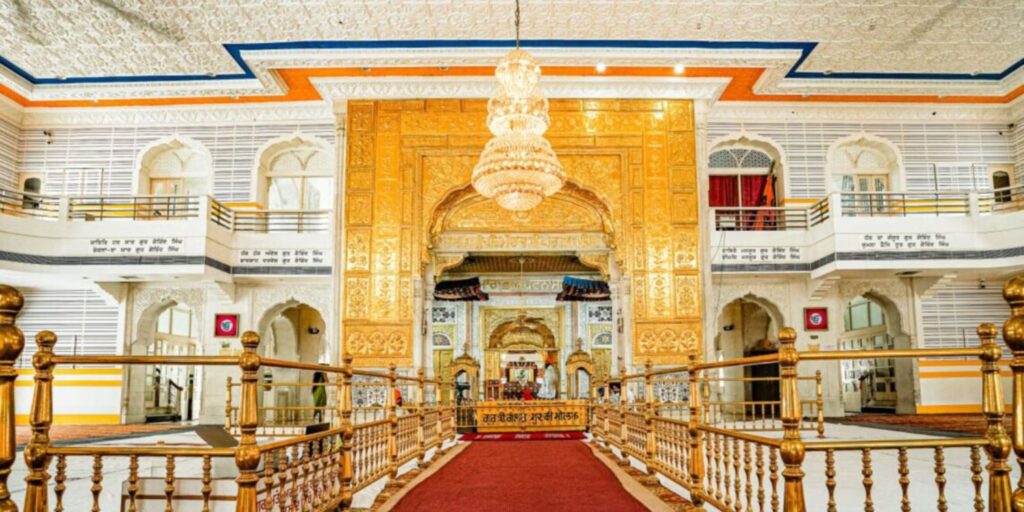Welcome to the spiritual heart of Bihar, where history and devotion converge, an ethereal sanctuary Patna Sahib Gurudwara.
However, situated in the bustling city of Patna, this sacred site holds profound significance in Sikhism as the birthplace of the 10th Sikh Guru, Guru Gobind Singh Ji.
Adorned with architectural splendor, Patna Sahib Gurudwara stands as a beacon of faith, drawing devotees from far and wide to experience its divine aura.
Further, stepping into the premises of Patna Sahib Gurudwara, one is enveloped by a sense of tranquility and reverence.
The majestic golden domes, intricately carved marble walls, and the soothing hymns echoing through the air create an atmosphere of profound spirituality.
Pilgrims embark on a journey of self-discovery and enlightenment, seeking solace and guidance in the teachings of Guru Gobind Singh Ji.
Additionally, as a testament to the rich heritage and enduring legacy of Sikhism, Patna Sahib Gurudwara serves as more than just a place of worship; it is a symbol of unity, compassion, and unwavering faith.
Join us on a soul-stirring pilgrimage to Patna Sahib Gurudwara, where every step is a testament to the enduring spirit of devotion.
Patna Sahib Gurudwara
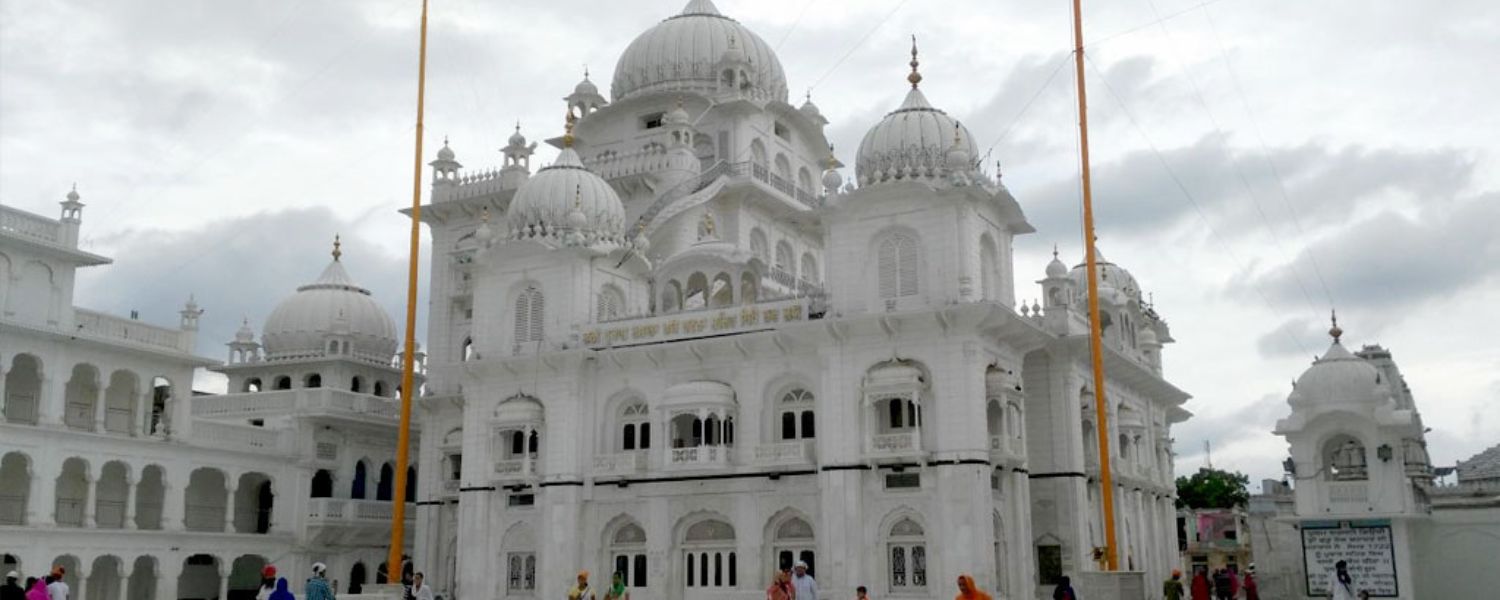
However, Patna Sahib Gurudwara stands as a monuments of Bihar tribute to the revered home place of Guru ji, the 10th Guru of the Sikhs, born in December 1666. This sacred site, Patna, Bihar, holds profound historical significance for the Sikh community worldwide.
Moreover, Maharaja Ranjit Singh, the illustrious first Maharaja of the Sikh Empire, undertook the noble endeavor of erecting this Gurudwara, encapsulating the spirit and legacy of Guru Gobind Singh.
Constructed during the 18th and 19th centuries, Patna Sahib Gurudwara exemplifies exquisite architectural finesse intertwined with spiritual sanctity.
Maharaja Ranjit Singh’s dedication to preserving Sikh heritage led to the establishment of numerous Gurdwaras across the Indian subcontinent, including this hallowed shrine.
Additionally, countless devotees flock to Patna Sahib Gurudwara each year to pay Guru Gobind Singh and seek spiritual solace. The Gurudwara is a beacon of faith, fostering a sense of unity and devotion among Sikhs worldwide.
Its tranquil ambiance and rich historical heritage inspire reverence and awe among visitors, transcending barriers of time and space.
Further, Patna Sahib Gurudwara serves as a sacred testament to the enduring legacy of Guru Gobind Singh and Maharaja Ranjit Singh’s unwavering commitment to Sikhism’s values and principles.
Its significance is deeply rooted in the hearts of devotees, perpetuating a legacy of spirituality and devotion for generations to come.
1. Importance of Patna Sahib in Sikhism
However, Takht Sri Patna Sahib, affectionately known as Harmandir Sahib, is a significant cornerstone in the tapestry of Sikhism. Further, in the heart of Patna Sahib, India, this revered Gurdwara holds profound importance for Sikhs worldwide.
Its sanctity emanates from its association with Guru Ji, the 10th Guru of the Sikhs, born here in December 1666. Patna Sahib Gurudwara isn’t merely a physical structure; it’s a spiritual beacon, drawing devotees from far and wide.
Additionally, its sacred ambiance evokes reverence, fostering a deep connection with Guru Gobind Singh’s life and teachings. Moreover, the Gurdwara is a pilgrimage site where Sikhs gather to pay homage, seek blessings, and immerse themselves in the divine atmosphere.
Mainly, the significance of Patna Sahib Gurudwara extends beyond its historical roots. It symbolizes resilience, as it has withstood the test of time, preserving the legacy of Guru Gobind Singh through centuries.
Moreover, it embodies the universal values of Sikhism, such as equality, compassion, and service to humanity, inspiring devotees to embrace these principles in their lives. For Sikhs, visiting Patna Sahib Gurudwara is more than a religious ritual; it’s a spiritual journey that deepens their faith and strengthens their bond with the Guru.
It serves as a reminder of the rich heritage and profound teachings that continue to guide and inspire millions around the globe. Patna Sahib Gurudwara remains a sacred sanctuary, perpetuating the essence of Sikhism for generations to come.
2. Guru Gobind Singh Ji’s Connection with Patna Sahib
Guru Gobind Singh Ji, the revered tenth Guru of the Sikh faith, shares a profound connection with Patna Sahib, located in the heart of Bihar, India.
However, born on 22nd December 1666, Guru Gobind Singh Ji entered the world in this historic city, enriching its legacy with his divine presence. Patna Sahib holds a special significance in Sikh history as the birthplace of this enlightened spiritual leader.
During his early years, Guru Gobind Singh Ji immersed himself in the vibrant surroundings of Patna, imbibing wisdom and spiritual teachings that would later shape his profound legacy. This sacred land witnessed the formative years of the Guru before he later moved to Anandpur Sahib.
Further, the connection between Guru Gobind Singh Ji and Patna Sahib extends beyond his birth, encompassing spiritual resonance and historical significance.
Moreover, the city was honored to host visits from other esteemed Sikh Gurus, including Guru Nanak Dev Ji and Guru Tegh Bahadur Ji, further enriching its spiritual heritage.
Today, Patna Sahib Gurudwara stands as a beacon of Sikh faith and culture, attracting devotees from far and wide to pay homage to Guru Gobind Singh Ji and seek spiritual solace in the sanctity of this sacred site.
Furthermore, the Gurudwara stands as a testament to the enduring legacy of Guru Gobind Singh Ji and the profound impact of his teachings on humanity.
Annual Celebrations and Festivals at Patna Sahib Gurudwara
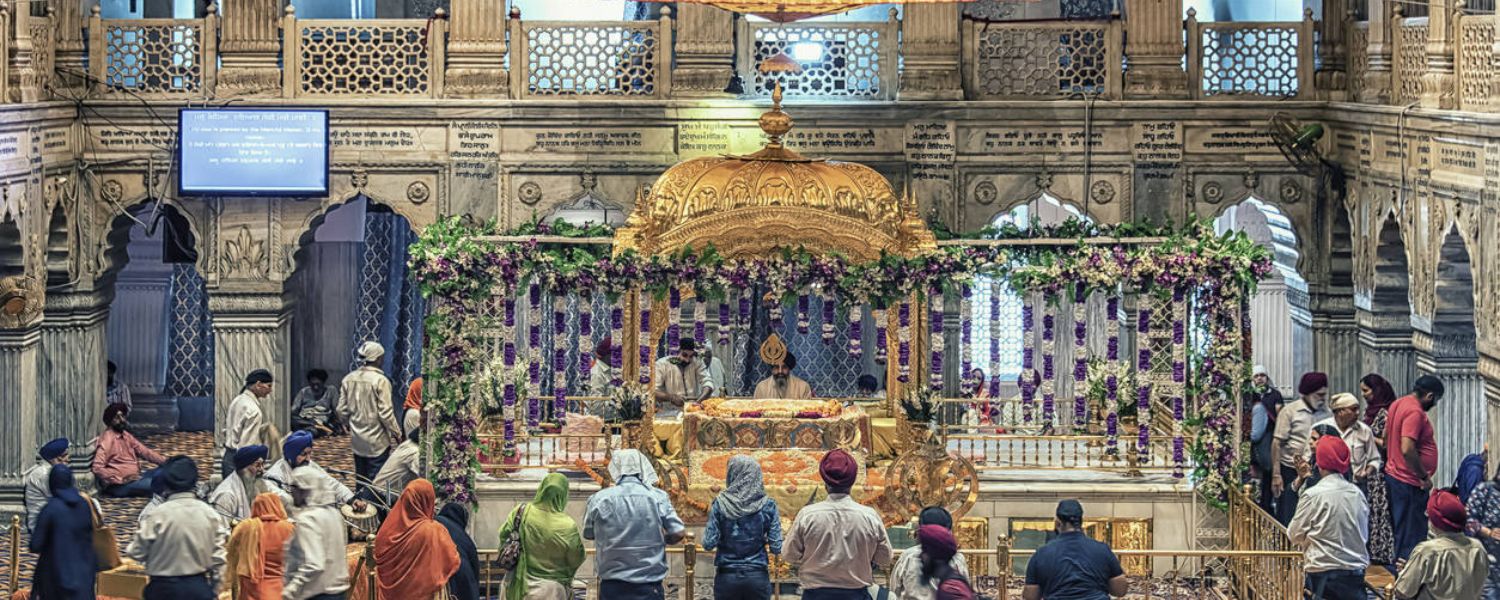
Every year, the vibrant city of Patna, India, comes alive with the joyous spirit of the Patna Sahib Mahotsav, a two-day cultural extravaganza celebrated near the revered Takht Sri Patna Sahib Gurudwara.
This annual festival, organized by the Tourism Department of the Government of Bihar, is a testament to the region’s rich cultural heritage and religious significance.
The festival typically coincides with the auspicious occasion of Baisakhi, commemorating the birth anniversary of the tenth Sikh Guru, Guru Gobind Singh.
During the Patna Sahib Mahotsav, the atmosphere in the city brims with excitement and enthusiasm as devotees and tourists from far and wide gather to partake in the festivities.
The event showcases a vibrant tapestry of cultural performances, including traditional music, dance, and theatrical presentations, reflecting the diversity and unity of Indian culture.
Pilgrims also seize the opportunity to pay their respects at the historic Takht Sri Patna Sahib Gurudwara, the birthplace of Guru Gobind Singh, further enhancing the spiritual significance of the celebration.
Beyond its religious and cultural aspects, the festival also serves to promote tourism and foster communal harmony.
Through various exhibitions, culinary delights, and interactive sessions, Patna Sahib Mahotsav offers visitors a glimpse into the rich tapestry of Bihar food culture, heritage, and hospitality.
It’s a time for celebration, reflection, and camaraderie, where people from all walks of life come together to revel in the joyous spirit of unity and brotherhood. Patna Sahib Mahotsav embodies the essence of the city’s soul, resonating with the timeless teachings of Guru Gobind Singh and fostering a sense of belonging among all who participate.
Gurudwaras under Patna sahib
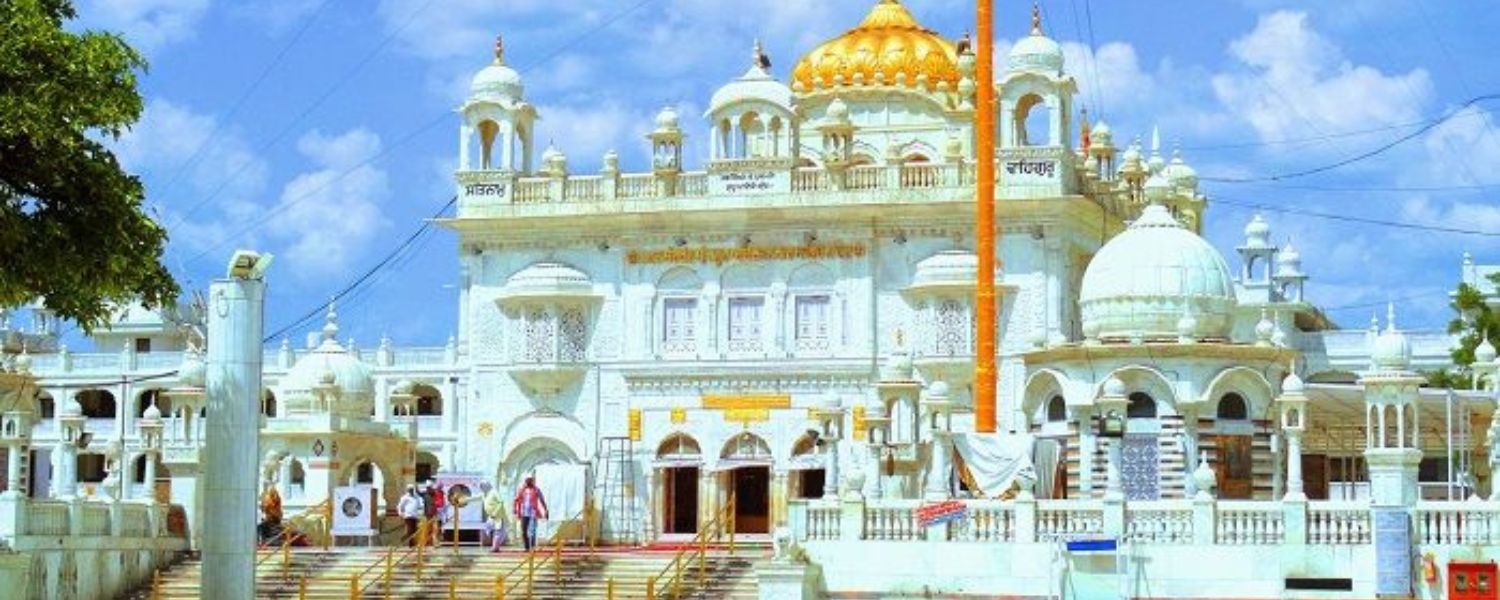
Patna Sahib Gurudwara is a revered site in Bihar, India’s heart. As the birthplace of Guru Gobind Singh Ji, the tenth Sikh Guru, this sacred complex exudes tranquility and reverence.
Patna Sahib Gurudwara, also known as Takht Sri Harmandir Sahib, symbolizes Sikh heritage and faith. Pilgrims from all corners of the world flock here to pay homage and seek blessings.
The gurudwara’s magnificent architecture, serene ambiance, and soothing hymns echoing through its halls create an atmosphere of divine connection and spiritual fulfillment. Plan your visit to Patna Sahib Gurudwara for a soul-stirring experience.
Patna Sahib Gurudwara, Patna
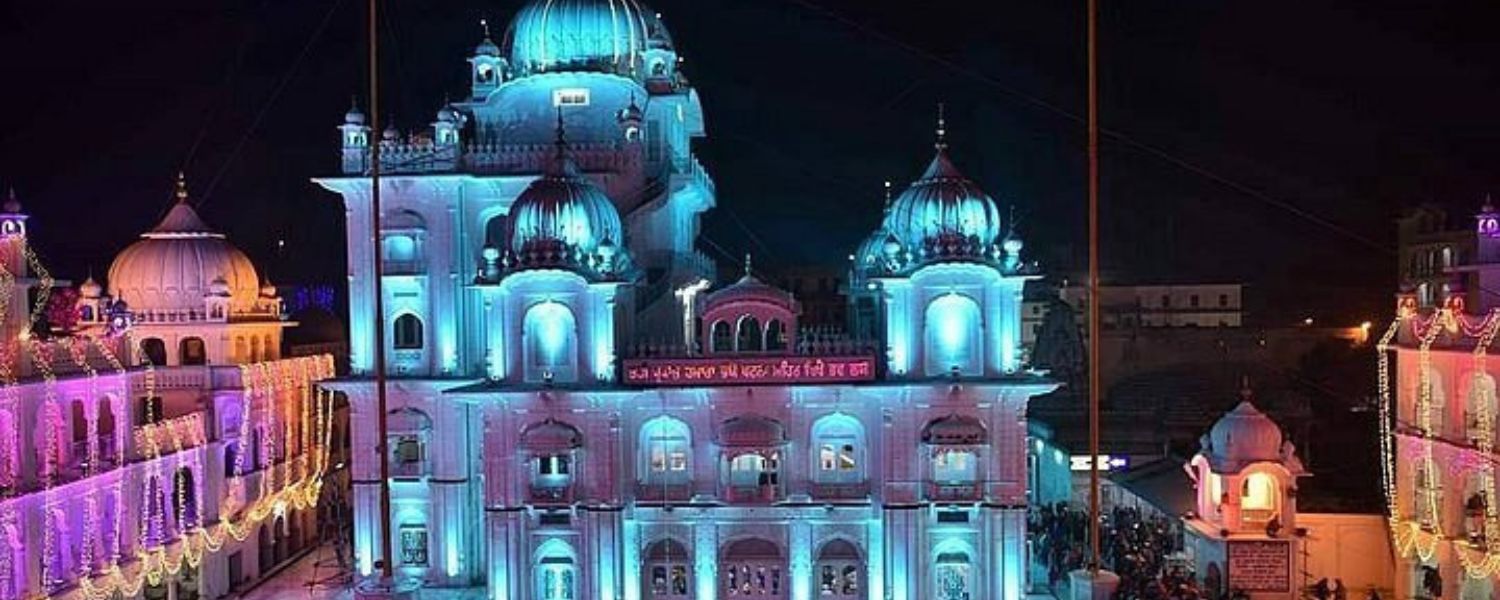
Patna Sahib Gurudwara, situated in Patna City, Bihar, India, holds profound significance in Sikhism. Also known as Patna Saheb, this revered gurudwara stands as a testament to the rich history and religious heritage of the Sikh community.
Patna City, often called the heart of Bihar, encapsulates centuries of cultural and spiritual essence within its ancient streets. With its roots tracing back to the historic city of Patliputra, Patna Sahib Gurudwara is revered as one of the holiest pilgrimage sites for Sikhs worldwide.
The gurudwara marks the birthplace of Guru Gobind Singh Ji, the tenth Sikh Guru and the founder of the Khalsa Panth. Thousands of individuals flock to this sacred site every year to pay their respects and seek blessings.
The architecture of Patna Sahib Gurudwara blends traditional Sikh and Mughal styles, reflecting the cultural amalgamation prevalent in the region.
The main shrine, Takht Sri Harmandir Sahib, symbolizes spiritual enlightenment and divine grace. Visitors to Patna Sahib Gurudwara immerse themselves in prayer and devotion and partake in the langar, a community kitchen offering free meals irrespective of caste, creed, or religion. This practice embodies the Sikh principle of selfless service and equality.
1. Gurudwara Sangat Sonar Toli Patna Sahib
Located near Shri Harimandir Ji in Patna Sahib, Gurudwara Sangat Sonar Toli holds a significant place in Sikh history. This serene Gurudwara commemorates Shri Guru Nanak Dev Ji’s visit to Patna, where he found solace near the banks of the river at what is now known as Shri Gau Ghat Sahib.
Legend has it that Guru Sahib blessed Bhai Mardana Ji with a precious gem during this time. However, when Bhai Mardana Ji attempted to sell it in the city, only Salas Rai Johri recognized its value.
This incident led to a profound lesson taught by Guru Nanak Dev Ji to Salas Rai Johri, emphasizing the importance of understanding and cherishing life’s true essence.
Gurudwara Sangat Sonar Toli is a poignant reminder of this timeless teaching, welcoming devotees from far and wide to seek spiritual solace and enlightenment.
Its serene ambiance and historical significance make it a cherished destination for worshippers and visitors alike.
As a beacon of spiritual wisdom and devotion, this Gurudwara holds a special place in the hearts of those who come to pay their respects, emphasizing the eternal values of understanding, empathy, and appreciation for the blessings of life.
Plan a visit to Patna Sahib Gurudwara and experience the profound teachings of Guru Nanak Dev Ji at Gurudwara Sangat Sonar Toli.
2. Gurudwara Ghai Ghat
Gurudwara Pahila Bara, popularly known as Gurudwara Ghai Ghat, holds significant reverence in Sikhism. Located in the vibrant city of Patna, Bihar, India, it stands as a testament to the teachings of Guru Nanak Dev, who established Sikhism.
This sacred place was erected in homage to Guru Nanak Dev’s visit to Patna, during which he lodged with Bhai Jaita, a devout individual who later embraced Guru Nanak Dev’s teachings and transformed his residence into a Dharamsala, now known as the Gurudwara Ghai Ghat.
Moreover, along the serene banks of the River Ganga, this Gurudwara offers a tranquil ambiance for spiritual reflection and relaxation. Gurudwara Ghai Ghat is a place of worship and a cherished repository of ancient relics.
Among its treasured possessions are the revered musical instrument, Rebeck of Bhai Mardana, and the bed and grindstone once used by Mata Gujri.
These relics serve as poignant reminders of this holy site’s rich heritage and profound spirituality. As it is often referred to, Patna Sahib Gurudwara attracts pilgrims from far and wide, seeking solace and divine blessings amidst its hallowed surroundings.
With its historical significance and serene ambiance, Gurudwara Ghai Ghat is an essential pilgrimage destination for devotees of Sikhism and seekers of spiritual enlightenment alike.
3. Gurudwara Shri Kangan Ghaat Sahib
Gurudwara Shri Kangan Ghaat Sahib, nestled on the serene banks of the majestic River Ganga in Patna, stands as a testament to the profound teachings of Sikhism. This exquisite white Gurudwara is significant in Sikh history, resonating with the spiritual essence that reverberates within its walls.
Legend has it that the Gurudwara gained its sanctity when the young Baal Gobind Rai, later known as Guru Gobind Singh Ji, displayed a profound act of renunciation.
Upon winning a game, he was bestowed with expensive gold bangles, which were symbolic of material wealth. Yet, in a powerful gesture against attachment to worldly possessions, he cast these precious bangles into the sacred waters of the Ganges, teaching a profound lesson on the futility of materialism.
The Gurudwara Shri Kangan Ghaat Sahib thus became a holy place of worship, embodying Guru Gobind Singh Ji’s teachings of devotion to the one true God, transcending idol worship and emphasizing spiritual connection above all else.
Its serene ambiance, coupled with the rhythmic flow of the Ganges, offers a tranquil setting for devotees and visitors alike to seek solace and spiritual enlightenment.
Gurudwara Shri Kangan Ghaat Sahib stands as a beacon of Sikh heritage and spiritual wisdom, inviting pilgrims from far and wide to experience the profound teachings and divine serenity that permeate its sacred grounds.
As one of the revered landmarks in tourist places in Patna Bihar, this Gurudwara continues to inspire and uplift souls, echoing the eternal truths of Sikhism for generations to come.
4. Gurudwara Shri Guru Ka Bagh Sahib
Gurudwara Shri Guru Ka Bagh Sahib is significant in Sikh history and is situated in Patna Sahib, Bihar. This sacred shrine marks where Guru Tegh Bahadur, the ninth Sikh Guru, had his first encounter.
Nestled within a lush bagh, or garden, once owned by the local nobles, the Gurudwara exudes an ambiance, surrounded by towering trees and vibrant flowers.
The serene atmosphere enveloping this site is believed to echo the spiritual essence of Guru Tegh Bahadur’s initial rendezvous here.
Legend has it that this serene garden was where Guru Tegh Bahadur’s journey of spiritual enlightenment began, making it a revered site among Sikhs worldwide.
The historical significance of this Gurudwara resonates deeply with devotees, as it commemorates the auspicious moment when the Guru’s divine mission commenced.
Visitors to Gurudwara Shri Guru Ka Bagh Sahib not only bask in its serene environment but also pay homage to the profound legacy of Guru Tegh Bahadur.
This sacred sanctuary serves as a reminder of the Guru’s teachings of compassion, humility, and selflessness, inspiring people to walk the path of righteousness.
With its rich history and serene ambiance, Gurudwara Shri Guru Ka Bagh Sahib stands as a testament to the enduring spiritual heritage of Sikhism, drawing pilgrims and seekers alike to its hallowed grounds.
5. Gurudwara Handi Sahib
Gurudwara Handi Sahib, located in the heart of Patna, holds profound historical significance in Sikhism. Dedicated to the revered Shri Tegh Bahadur Ji, this sacred site commemorates a poignant moment in Sikh history.
Legend has it that Guru Tegh Bahadur Ji and his followers once visited Patna and were welcomed with a simple yet heartwarming langar, served from a minor clay pitcher in a modest hut.
The tale takes a significant turn when, upon his return in 1670, Guru Tegh Bahadur Ji encountered an older woman who empathized with his situation.
Moved by her compassion, she presented him with a kettle full of khichadi, a gesture that deeply touched the Guru. In honor of this act of kindness, a langar was established in her humble abode, situated by a seasonal stream, encompassed by a brick-paved walled compound and a verandah on three sides.
This sacred space became known as Handiwali Sangat, eventually evolving into the revered Gurudwara Handi Sahib. Today, it is a testament to the values of compassion, humility, and communal harmony integral to Sikhism.
As it is often referred to, Patna Sahib Gurudwara continues to draw devotees and visitors from far and wide, seeking spiritual solace and inspiration from its storied past.
6. Gurdwara Bal Leela Maini Sangat
Located in Patna Sahib, Gurdwara Bal Leela Maini Sangat holds a special significance in Sikh history. This revered Gurudwara stands as a tribute to the hospitality and affection of Raja Fateh Chand Maini towards young Guru Gobind Das, later known as Guru Gobind Singh Ji.
The historical significance lies in the fact that Raja Fateh Chand Maini’s house was where Guru Gobind Das frequented and was treated with utmost care and warmth.
Moreover, legend has it that Guru Gobind Das would often visit the Maini residence, where Raja Fateh Chand Maini and his wife welcomed him with open arms. The Rani, despite her inability to bear children, found solace and joy in the presence of Guru Gobind Das.
As she watched him play with his friends one day, her heart brimmed with admiration, and she prayed fervently to have a son like him. However, her prayers were answered when young Guruji, in a divine moment, sat in her lap and addressed her as his mother.
This profound incident solidified the bond between Guru Gobind Das and the Maini family. Today, Gurdwara Bal Leela Maini Sangat is a symbol of this sacred connection and continues attracting devotees who seek blessings and inspiration from this divine narrative of love and compassion.
Conclusion
In conclusion, Patna Sahib Gurudwara is a timeless emblem of spiritual reverence and historical significance within Sikhism. Its sacred grounds not only commemorate the birthplace of Guru Ji, the 10th Sikh Guru, but also serve as a beacon of unity, humility, and devotion for millions of followers worldwide.
However, the serenity that envelopes the gurudwara’s premises invites devotees to seek solace, reflect on the teachings of Guru Nanak Dev Ji, and partake in the community’s selfless service, or seva.
However, through its architectural grandeur and profound spiritual aura, Patna Sahib Gurudwara transcends mere physical boundaries, embracing all who enter with warmth and acceptance.
As pilgrims gather to pay homage and connect with their faith, they are reminded of the enduring legacy of Guru Gobind Singh Ji and the timeless values he espoused.
Thus, Patna Sahib Gurudwara stands not only as a place of worship but as a testament to the enduring spirit of Sikhism, inspiring generations to come.
FAQ
Q. How many gurdwaras are there in Patna Sahib?
Patna Sahib is home to several gurdwaras, but the most prominent and revered one is Takht Sri Harmandir Sahib, also known as Patna Sahib Gurudwara.
Q. What is the full name of Patna Gurudwara?
The full name of the Gurudwara in Patna is Takht Sri Harmandir Sahib, commonly referred to as Patna Sahib Gurudwara.
Q. What is Patna Sahib’s daily routine?
Patna Sahib follows a routine that includes early morning prayers, known as Prabhat Pheri, followed by the continuous recitation of Guru Granth Sahib. Langar, the community kitchen, serves free meals to visitors throughout the day.
Q. What to buy in Patna Sahib?
Visitors often purchase souvenirs such as religious books, photographs, and mementos from the Gurudwara gift shop as a token of their visit.
Q. What is the specialty of Patna Sahib?
Patna Sahib holds immense historical and religious significance as it is the home place of Guru Gobind Singh Ji, the tenth Sikh Guru. Pilgrims from all over the world visit Patna Sahib to pay their respects and seek blessings. The Gurudwara also serves as a symbol of unity and equality, embodying the core principles of Sikhism.
